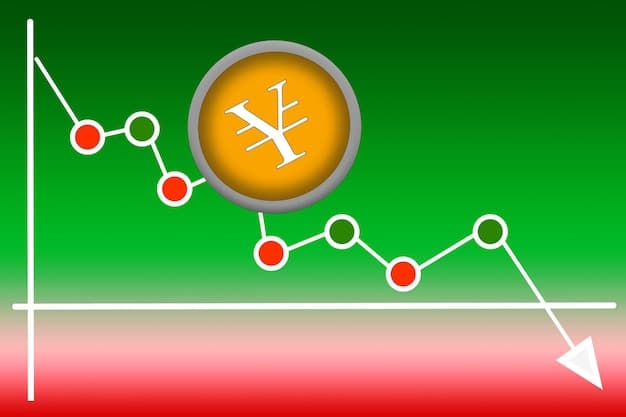Mexican Peso Forecast: 5% Fluctuation Impact on US Businesses

Predicting the Mexican Peso Forecast: What a 5% Fluctuation Against the US Dollar Means for Your Business in the Next Quarter is crucial for US companies, as even minor shifts can significantly alter import/export costs, profit margins, and supply chain stability, demanding proactive strategic adjustments to mitigate risks and capitalize on opportunities.
For US businesses engaged with Mexico, understanding the intricacies of currency fluctuations is not merely an academic exercise; it’s a critical component of strategic planning. This article delves into the potential ramifications of a Mexican Peso Forecast: What a 5% Fluctuation Against the US Dollar Means for Your Business in the Next Quarter, offering insights grounded in economic realities and practical business considerations.
Understanding the Dynamics of the Mexican Peso
The Mexican peso (MXN) is one of the most traded emerging market currencies globally, and its volatility against the US dollar (USD) can have profound implications. Several factors contribute to this dynamic relationship, ranging from macroeconomic indicators to geopolitical developments.
Pinpointing the exact drivers of a 5% fluctuation requires a nuanced look at both internal Mexican economic health and external global influences. For instance, interest rate differentials between the Banxico (Mexico’s central bank) and the Federal Reserve play a significant role. A larger interest rate gap, where Mexico offers higher rates, tends to attract foreign investment, strengthening the peso. Conversely, a narrowing gap or perceived risk in Mexico can lead to capital flight and peso depreciation.
Key Influencing Factors
Understanding these drivers is crucial for any business looking to hedge against or capitalize on currency movements. It’s not just about the numbers but the underlying narrative behind them.
- Interest Rate Differentials: The gap between Banxico and Federal Reserve rates can attract or repel short-term capital.
- Oil Prices: Mexico’s economy is a significant oil producer, so global oil price movements heavily influence the peso.
- Trade Flows: The volume and balance of trade between Mexico and the US directly impact currency demand.
- Political Stability: Domestic and international political events, including elections and policy changes, introduce uncertainty.
The Role of Economic Data
Beyond these broad factors, specific economic data releases from both nations provide critical insights. Inflation rates, employment figures, GDP growth, and manufacturing output are all closely watched. A stronger than expected US jobs report, for example, could signal tighter monetary policy from the Fed, potentially strengthening the dollar against the peso. Similarly, robust industrial production in Mexico might suggest a stronger economic outlook, supporting the peso. These data points act as real-time indicators, influencing trader sentiment and investment decisions on a daily basis, making them essential for a forward-looking analysis.
The confluence of these elements creates a complex, interconnected web that dictates the peso’s trajectory. Businesses must therefore adopt a holistic view, integrating various data streams into their forecast models.
Impact of a 5% Peso Depreciation on US Businesses
A 5% depreciation of the Mexican peso against the US dollar means that it takes more pesos to buy one dollar. This shift has multifaceted implications for US businesses, particularly those involved in cross-border trade, manufacturing, or services.
From the perspective of US companies importing goods from Mexico, a weaker peso is generally beneficial. Mexican goods become cheaper in dollar terms, leading to lower procurement costs. This can translate into higher profit margins or the ability to offer more competitive prices in the US market. For instance, a US company importing auto parts from Mexico would find those parts 5% cheaper, assuming the Mexican supplier’s pricing in pesos remains stable. This cost saving can be significant for businesses with substantial import volumes.
Winners and Losers in the US Market
While importers may rejoice, US companies exporting to Mexico face a less favorable scenario. A 5% stronger dollar means US goods become more expensive for Mexican buyers. This can dampen demand, reduce sales volumes, and potentially erode market share if Mexican consumers or businesses opt for locally produced alternatives or imports from other countries with more favorable exchange rates. A US agricultural exporter, for example, might see a decline in sales to Mexico as their produce becomes comparatively pricier.
- Importers: Benefit from lower import costs, potentially increasing profit margins or allowing for competitive pricing strategies.
- Exporters: Face higher costs for Mexican buyers, which can reduce demand and market share.
- Manufacturers with Mexican Operations: May see reduced labor and production costs if wages are peso-denominated, but potentially higher costs for imported raw materials.
- Tourism: US tourists visiting Mexico find their dollars stretch further, making vacations more affordable. Mexican tourists visiting the US face higher costs.
Supply Chain Implications
Beyond direct trade, a depreciating peso can also impact global supply chains. Many US companies have manufacturing operations or significant input suppliers in Mexico. Labor costs, if paid in pesos, become cheaper in dollar terms, potentially improving operating margins for US-owned factories in Mexico. However, if these operations rely on imported raw materials priced in dollars, the cost savings on labor might be partially offset. Businesses need to analyze their entire cost structure to assess the net impact. Furthermore, contracts denominated in pesos versus dollars become crucial in determining the immediate financial effect of such a fluctuation. Businesses with contracts locked in at a specific exchange rate for a period may be temporarily insulated, but will face adjustments upon renewal.
Strategic hedging, through financial instruments like forward contracts or options, becomes a vital tool for mitigating currency risk and ensuring stability in an otherwise volatile environment. The potential for a 5% swing underscores the need for constant vigilance and proactive risk management strategies.

Impact of a 5% Peso Appreciation on US Businesses
Conversely, a 5% appreciation of the Mexican peso against the US dollar signifies that it takes fewer pesos to buy one dollar. This scenario presents a distinct set of challenges and opportunities for US companies with ties to the Mexican economy.
For US businesses that import goods from Mexico, a stronger peso means higher procurement costs. Products and services sourced from Mexico become 5% more expensive in dollar terms. This can compress profit margins or necessitate price increases, potentially making these businesses less competitive unless they can absorb the additional cost or find alternative, cheaper suppliers. A US furniture retailer importing handcrafted pieces from Mexico, for example, would see their landed costs rise, forcing them to re-evaluate their pricing strategy or supplier relationships.
Beneficiaries of a Stronger Peso
While importers face headwinds, US companies exporting to Mexico typically benefit from a peso appreciation. Their goods become relatively cheaper for Mexican buyers, potentially boosting demand, increasing sales volumes, and expanding market share. A stronger peso enhances the purchasing power of Mexican consumers and businesses when buying US products. A US technology firm selling software licenses to Mexican enterprises would find their offerings more attractive and affordable, possibly leading to increased export revenue.
- Importers: Face higher import costs, potentially squeezing profit margins or requiring price adjustments.
- Exporters: Benefit from increased purchasing power of Mexican buyers, potentially boosting sales and market share.
- Manufacturers with Mexican Operations: May see increased labor costs if peso-denominated, but potentially lower costs for dollar-denominated imported raw materials.
- Tourism: US tourists visiting Mexico find their dollars buy less, making vacations more expensive. Mexican tourists visiting the US benefit from increased purchasing power.
Investment and Repatriation Considerations
For US companies with direct investments or operations in Mexico, a stronger peso can have mixed effects. On one hand, the dollar equivalent of peso-denominated profits repatriated to the US would be higher, improving reported earnings. This can be a significant boost for companies with substantial operations in Mexico. On the other hand, if a US company has peso-denominated debt in Mexico, a stronger peso could make it seem more expensive to service if the principal and interest are paid in dollars, though this varies based on specific loan agreements. Furthermore, local operational expenses, if paid in pesos, would translate to a higher dollar cost, potentially impacting overall operational efficiency and profitability when viewed from a dollar perspective. Businesses must carefully assess their balance sheets and income statements concerning currency exposures to fully grasp the implications of such a shift.
Just as with depreciation, proactive currency risk management, including hedging strategies, remains paramount when facing a potential peso appreciation. Businesses that are strategically prepared for both appreciation and depreciation are better positioned to navigate the complexities of cross-border financial flows.
Strategic Financial Planning for Currency Volatility
Navigating currency volatility, whether a 5% peso appreciation or depreciation, demands robust strategic financial planning. It’s not enough to simply observe the fluctuations; businesses must proactively implement measures to mitigate risks and capitalize on opportunities.
One of the primary tools in this regard is currency hedging. This involves using financial instruments to lock in an exchange rate for future transactions, thereby reducing uncertainty. Common hedging instruments include forward contracts, options, and currency swaps. A forward contract, for instance, allows a business to agree today on an exchange rate for a transaction that will occur at a future date. This provides certainty for import or export costs, protecting profit margins from adverse currency movements. While hedging incurs costs, these are often viewed as an insurance premium against potentially much larger losses due to unfavorable exchange rate shifts. Different hedging strategies exist, from full coverage to partial hedging, and the optimal approach depends on a company’s risk appetite and exposure.
Mitigation Strategies
Beyond hedging, businesses can explore several other operational and financial strategies to build resilience against currency fluctuations. These strategies aim to diversify risk and increase flexibility.
- Diversify Supply Chains: Reduce over-reliance on a single country or currency for inputs.
- Local Currency Billing: Negotiate with partners to bill in your home currency where possible, shifting exchange rate risk.
- Natural Hedging: Balance revenues and expenses in the same currency (e.g., earning pesos from sales to offset peso-denominated labor costs).
- Dynamic Pricing: Adjust pricing models to reflect real-time currency shifts, albeit carefully to avoid alienating customers.
Cash Flow and Liquidity Management
Effective cash flow and liquidity management become even more critical during periods of currency volatility. Businesses need to ensure they have sufficient liquidity to cover potential unexpected costs arising from currency movements, especially for short-term liabilities. This might involve maintaining larger cash reserves, establishing credit lines, or optimizing payment cycles with suppliers and customers. Furthermore, scenario planning and stress testing financial models against various exchange rate scenarios can help identify potential vulnerabilities and inform contingency plans. Understanding the timing of cash inflows and outflows relative to expected currency movements allows companies to make more informed decisions about when to convert currencies, aiming to maximize value.
Ultimately, strategic financial planning for currency volatility is about fostering a proactive mindset. It’s about anticipating potential shifts and having a predefined course of action rather than reacting to events. By combining hedging, operational adjustments, and astute financial management, US businesses can better navigate the unpredictable waters of the Mexican peso.
The Evolving Landscape of Nearshoring and Reshoring
The concept of nearshoring – bringing production closer to home, often to Mexico for US companies – has gained significant traction in recent years, driven by supply chain disruptions, geopolitical shifts, and the desire for greater control over manufacturing processes. A 5% fluctuation in the Mexican peso can profoundly influence the economic calculus behind these nearshoring strategies.
When the peso depreciates, it strengthens the argument for nearshoring to Mexico. Labor costs and other local expenses become cheaper in dollar terms, enhancing Mexico’s attractiveness as a manufacturing hub. This could lead US companies to accelerate their investments in Mexican production facilities or increase their reliance on Mexican suppliers. The cost savings gained from a weaker peso can help offset initial investment costs or improve ongoing operational margins, making nearshoring a more compelling proposition for businesses seeking both cost efficiency and proximity to the US market. The “China plus one” strategy, where companies diversify away from China and often choose Mexico as an alternative, would see further impetus under a depreciating peso scenario.
Impact of Currency on Location Decisions
Conversely, a sustained appreciation of the peso could temper the enthusiasm for nearshoring. If Mexican labor and operational costs become significantly more expensive in dollar terms, the cost-benefit analysis might shift, potentially making US domestic production (reshoring) or other nearshoring locations more appealing. While other factors like logistics, qualified labor, intellectual property protection, and trade agreements will always play a role, currency valuations can significantly impact the long-term profitability of these location decisions. Businesses must model these currency impacts over the expected lifespan of their investments, not just short-term fluctuations.
- Depreciating Peso: Enhances Mexico’s competitiveness for nearshoring due to lower labor and operational costs.
- Appreciating Peso: May reduce the cost advantage of nearshoring to Mexico, potentially favoring reshoring or other manufacturing locations.
- Supply Chain Resilience: Nearshoring offers advantages in stability and reduced lead times, irrespective of minor currency shifts.
- Trade Agreements: USMCA (United States-Mexico-Canada Agreement) continues to underpin the nearshoring trend, offering tariff-free access.
Beyond Currency: Holistic Considerations
It’s important to recognize that currency is just one variable in the complex equation of nearshoring and reshoring. Factors such as geographical proximity, established trade agreements (like the USMCA), skilled labor availability, and robust logistics infrastructure in Mexico continue to make it an attractive option for US businesses, even amidst currency volatility. The desire for supply chain resilience, reduced transit times, and improved responsiveness to market demands often outweighs minor currency fluctuations for many strategic decisions. However, a significant or sustained currency shift can certainly tip the scales, compelling businesses to re-evaluate their long-term manufacturing and sourcing strategies. Ultimately, the decision to nearshore or reshore is a holistic one, where currency factors are weighed alongside a multitude of operational and strategic considerations.
The interplay of these factors means that businesses contemplating or already engaged in nearshoring need a dynamic assessment framework that accounts for currency shifts, ensuring their supply chain strategies remain robust and cost-effective over time.
Long-Term Economic Outlook and Policy Implications
Beyond the immediate quarter, understanding the long-term economic outlook for both Mexico and the US, along with potential policy shifts, is crucial for businesses. The trajectory of a 5% peso fluctuation is not just a matter of short-term trading but reflects deeper economic fundamentals and future policy directions.
Mexico’s economic growth prospects are influenced by various factors, including internal reforms, investment in infrastructure, and the health of its trade relationship with the US. Policies aimed at attracting foreign direct investment (FDI), improving education, and combating corruption can bolster the peso’s long-term stability and strength. Conversely, political instability or protectionist trade policies could put downward pressure on the currency. From a US perspective, the Federal Reserve’s monetary policy decisions – particularly regarding interest rates – will continue to be a dominant factor in the USD/MXN exchange rate. A hawkish Fed, signaling higher rates, typically strengthens the dollar, while a dovish stance could weaken it.
Government Policies and Bi-Lateral Relations
The relationship between the US and Mexican governments, particularly concerning trade and border issues, can also significantly impact currency sentiment. The USMCA agreement provides a framework for trade, but ongoing negotiations or disputes can introduce uncertainty. For instance, any discussions around renewable energy policies in Mexico or specific sector regulations could influence investment flows and, consequently, the peso’s value. Businesses should monitor these policy dialogues closely, as they can signal future shifts in economic priorities that impact cross-border operations and financial flows. Stability in bi-lateral relations tends to foster confidence in the peso, encouraging investment and trade.
- Monetary Policy: Federal Reserve and Banxico interest rate decisions remain critical drivers.
- Fiscal Policy: Government spending, debt levels, and budget deficits impact economic stability.
- Trade Agreements: Implementation and potential renegotiation of USMCA influence trade flows.
- Political Stability: Domestic and international political events shape investor confidence.
Demographics and Consumption Patterns
Long-term demographic trends and changing consumption patterns in both countries also play a role. Mexico’s young and growing population presents a significant consumer market, and rising middle-class incomes over time could increase demand for US goods and services, potentially strengthening the peso. In the US, shifts in demand for goods manufactured or agricultural products sourced from Mexico could similarly impact trade balances and currency flows. These underlying demographic and economic structural changes exert a slow but steady pressure on currency valuations, providing a foundational context for short-term fluctuations. Understanding these broader trends helps businesses to position themselves for long-term growth and stability, moving beyond just reacting to quarterly currency movements.
Therefore, a comprehensive long-term outlook requires integrating these policy and macro-economic considerations into any forecast, providing a more robust framework for strategic decision-making. The ability to anticipate and adapt to these shifts is key to sustained success for businesses operating across the US-Mexico border.
Future Outlook: Navigating Uncertainty and Opportunity
As businesses look ahead, the ability to navigate currency uncertainty effectively will be a defining factor in fostering long-term resilience and capitalizing on emerging opportunities. A 5% fluctuation in the Mexican peso over the next quarter serves as a vivid reminder of the market’s inherent volatility, but it also highlights areas where adaptable strategies can lead to competitive advantages.
The future outlook for the peso will continue to be shaped by a confluence of global economic health, commodity prices, and the specific policy decisions made by both the US Federal Reserve and Banxico. Businesses should therefore prioritize real-time data analysis and invest in robust forecasting tools that go beyond simple historical trends. Integrating machine learning and AI-driven predictive analytics might offer a more nuanced understanding of complex market dynamics, enabling more accurate and timely decision-making. However, even the most sophisticated models cannot entirely eliminate uncertainty, making agility and contingency planning paramount.
Embracing Digital Transformation for Resilience
Digital transformation offers significant avenues for enhancing operational resilience in the face of currency fluctuations. Automating finance processes, leveraging cloud-based ERP systems, and implementing advanced analytics can provide businesses with immediate insights into their currency exposures. This visibility allows for quicker adjustments to pricing, procurement, and supply chain strategies. For example, real-time tracking of import costs in different currencies enables swift decisions on supplier diversification or hedging strategies, thereby minimizing the impact of adverse currency movements. The integration of financial data with operational metrics provides a holistic view, empowering management to make informed decisions swiftly.
- Advanced Analytics: Utilize AI and machine learning for more precise currency forecasts.
- Automated Hedging: Implement systems for automated execution of hedging strategies.
- Supply Chain Diversification: Continue building resilient, multi-country sourcing networks.
- Flexible Contracts: Negotiate contracts with dynamic clauses to account for currency swings.
Collaboration and Knowledge Sharing
In a globalized economy, collaboration and knowledge sharing across industries can also be a powerful tool. Participation in industry forums, engaging with economic experts, and fostering stronger ties with cross-border partners can provide invaluable insights into market sentiment and emerging trends. Understanding how competitors and partners are addressing currency risks can inform best practices and identify collective opportunities. For example, shared market intelligence on the availability of new hedging instruments or the efficacy of particular risk management strategies can benefit the entire ecosystem. The future rewards those businesses that not only react to change but actively engage in shaping their response through informed decision-making and strategic partnerships, transforming volatility into a source of strategic advantage rather than just a challenge.
The key takeaway is that while currency fluctuations are an inherent part of international business, their impact can be effectively managed through a combination of foresight, technological adoption, and collaborative strategies. For US businesses, understanding the potential for a 5% shift in the Mexican peso is not just about risk avoidance, but about identifying and seizing opportunities for growth in a dynamic cross-border market.
| Key Point | Brief Description |
|---|---|
| 📊 Currency Impact | A 5% MXN fluctuation significantly alters import/export costs and profit margins for US businesses. |
| 🛡️ Risk Mitigation | Hedging strategies like forward contracts are essential to stabilize costs and revenues. |
| 🏭 Nearshoring Effect | A weaker peso enhances Mexico’s appeal as a manufacturing hub, boosting nearshoring trends. |
| 📈 Economic Indicators | Interest rates, oil prices, and trade flows are key drivers influencing peso valuation. |
Frequently Asked Questions
The Mexican peso’s volatility against the US dollar is influenced by factors like interest rate differentials between Banxico and the Federal Reserve, global oil prices, trade flows between the US and Mexico, and political stability in both nations. As an emerging market currency, it’s also susceptible to shifts in global investor sentiment and risk appetite.
A peso depreciation makes Mexican goods and services cheaper in dollar terms for US importers. This can lead to lower procurement costs, potentially increasing profit margins or allowing US businesses to offer more competitive prices in their domestic market, thus benefiting their bottom line.
If the peso appreciates, US goods become relatively cheaper for Mexican buyers. This can boost demand for US exports, potentially increasing sales volumes and market share for US companies. Mexican consumers and businesses gain greater purchasing power for dollar-denominated products.
Businesses can utilize currency hedging instruments like forward contracts to lock in exchange rates. Other strategies include diversifying supply chains, negotiating billing in their home currency, balancing revenues and expenses in the same currency (natural hedging), and implementing dynamic pricing models.
A depreciating peso typically enhances Mexico’s attractiveness for nearshoring by lowering labor and operational costs in dollar terms. Conversely, a strong peso might reduce this cost advantage, potentially shifting some focus towards reshoring or other nearshoring locations, though other strategic factors remain key.
Conclusion
The intricate dance between the Mexican peso and the US dollar is a constant consideration for businesses operating across the border. As we’ve explored, a 5% fluctuation, whether an appreciation or depreciation, is far from a minor detail; it represents a significant shift that can profoundly impact import and export costs, profit margins, supply chain strategies, and even long-term investment decisions. For US businesses, understanding the underlying drivers of these currency movements—from interest rate differentials and oil prices to political stability and trade agreements—is fundamental. Moreover, proactively adopting strategic financial planning, including robust hedging policies, supply chain diversification, and embracing digital transformation, is not merely advisable but essential. The evolving landscape of nearshoring underscores how currency dynamics are woven into broader operational considerations. Ultimately, navigating the uncertainty of currency markets requires a blend of foresight, adaptability, and continuous learning, transforming potential risks into opportunities for growth and resilience in the dynamic Mexican-US economic relationship.




